|
|
|
INTEGRATED WETLAND SYSTEM-JAKKUR MODEL
Integrated wetlands system consists of sewage treatment plant, constructed wetlands (with location specific macrophytes) and algal pond integrated with a lake (figure 3.1). Constructed wetland aid in water purification (nutrient, heavy metal and xenobiotics removal) and flood control through physical, chemical, and biological processes. When sewage is released into an environment containing macrophytes and algae a series of actions takes place. Through contact with biofilms, plant roots and rhizomes processes like nitrification, ammonification and plant uptake will decrease the nutrient level (nitrate and phosphates) in wastewater. Algae based lagoons treat wastewater by natural oxidative processes. Various zones in lagoons function equivalent to cascaded anaerobic lagoon, facultative aerated lagoons followed by maturation ponds. Microbes aid in the removal of nutrients and are influenced by wind, sunlight and other factors (Ramachandra et al., 2014). This model is working satisfactorily at Jakkur. The sewage treatment plant removes contaminants (evident from lower COD and BOD) and mineralises organic nutrients (NO3-N, PO43- P to inorganic constituents. Integration of the conventional treatment system with wetlands [consisting of reed bed (with typha etc.) and algal pond] would help in the complete removal of nutrients in the cost effective way. Four to five days of residence time in the lake helps in the removal of pathogen apart from nutrients. However, this requires regular maintenance through harvesting macrophytes and algae (from algal ponds). Harvested algae would have energy value, which could be used for biofuel production. The combined activity of algae and macrophytes helps in the removal of ~45% COD, ~66 % BOD, ~33 % NO3-N and ~40 % PO43-P. Jakkur lake acts as the final level of treatment that removes ~32 % COD, ~23% BOD, ~ 0.3 % NO3-N and ~34 % PO43-P. The lake water with a nominal effort of sunlight exposure and filtration would provide potable water. Replication of this model in rapidly urbanizing landscapes (such as Bangalore, Delhi, etc.) would help in meeting the water demand and also mitigating water scarcity through recharging of groundwater sources with remediation.


Figure 3.1: Jakkur model
PROPOSED CONSTRUCTED WETLAND MODEL AT BELLANDUR
Bellandur lake, located in south eastern part of Bangalore city along the Koramangala Challaghatta valley, that joins Dakshina Pinakini river flowing to the Bay of Bengal. Bellandur lake has a catchment area about 279 sq.km, while the lake being the largest in Bangalore has an area about 366.9 hectares. The lake has three major inlets from i) Agaram ii) ST bed iii) HAL, sides respectively receiving at least 400 MLD water. Inlet from Agarma side contributes nearly 128 MLD of sewage and inlet from ST bed side of the lake contributes to 102 MLD of sewage (Figure. 3.2), which can be biologically treated at the inlets of the lake. RMP of 2015 indicates a treatment facility at the Agaram Bellandur side of the lake, whereas the same area is now being used for SEZ (Figure 3.3). The under construction SEZ has encroached the lake bed, violated the norms of minimum buffer zones with respect to the drainage networks, altered the drainage lands (encroached kharab lands). As per NGT, the encroached lake bed has to be recovered by the government. The SEZ is being built in the valley zone (contrary to RMP 2015) is to be shifted elsewhere and the recovered wetlands area will aid in creating integrated water treatment systems (fig 3.3.1).

Figure 3.2: Sewage generated at Bellandur Inlets
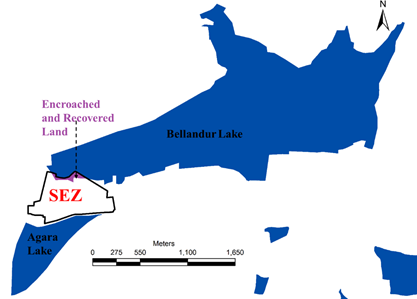
Figure 3.3: SEZ, Bellandur and Agara lakes.
In order to treat the water from Agaram and ST bed side inlet of the lakes, biological treatment methods can be adopted and is as described in Figure 3.4.
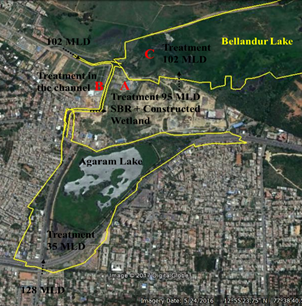
Figure 3.3.1: Proposed Sewage Treatment with wetlands
Along the Agaram side of the lake, about 35 MLD of 128 MLD is planned to be treated upstream of Agaram lake by the government agency, and remaining 93 MLD can be treated by planning SBR and constructed wetland in the current said SEZ area (Site A) and is as described in Table 1 and Figure 3.4. SBR treatment on an average requires nearly ~0.045 hectares of land for treating 1 MLD of water (Ramachandra, et.at., 2017 – ETR 116), based on this, to treat about 95 MLD, ~4.3 hectares (~10.5 – 12 acres) of land is required for having SBR system. The sewage at Bellandur has a BOD ranging between 120 – 410 mg/l, COD 190 -960 mg/l, Total Suspended Solids 90 – 390 mg/l, though SBR treatment, BOD can be reduced to less than 10 mg/l, COD < 50mg/l, TSS < 10. (Ramachandra et al, 2017 – ETR 116). The constructed wetlands in the downstream of the SBR has the ability to take up the nutrients in the systems, the advantage of constructed wetlands area they are efficient, cost effective and requires a very low maintenance. Frequent harvesting of the macrophytes is necessary to maintain the constructed wetlands. To treat 95 MLD of water from the SBR outlet, an area of nearly 73.8 acres (30 hectares) is necessary. The area of the wetlands is estimated using the equation

Where A is the area of the constructed wetland in square meters, Qd is the average inflow as cubic meters per day. Ci and Ce are the influent and effluent BOD as milligram per litre, KBOD is a factor (0.1) Table 3.1 indicates various parameters and area requirement under the wetlands.
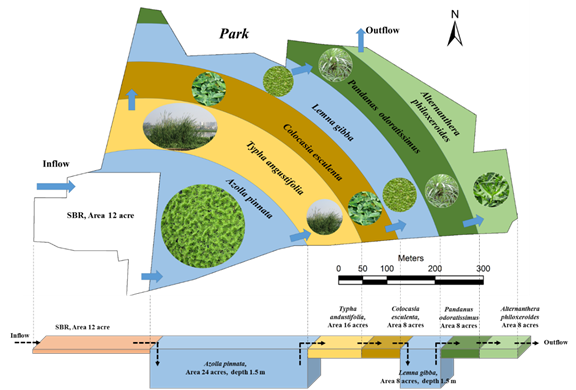
Figure 3.4: Conceptual treatment model at Bellandur inlet: 95 MLD (A)
Various macrophytes that can be grown in the wetlands are depicted in sequence in Figure 3.4, along with the depth requirements.
Table 3.1: Estimation of Wetland Area requirements
Slno |
Description |
Units of measurement |
Quantity |
1 |
Q - Discharge |
MLD |
95 |
2 |
cum/day |
95000 |
3 |
SBR area requirement |
Ha/MLD |
0.045 |
4 |
Ha |
4.3 |
5 |
Acre |
10.6 |
6 |
Sewage treatment plant area |
Acre |
12 |
WETLAND |
7 |
Ci - input BOD |
mg/ltr |
10 |
8 |
Co - output BOD |
mg/ltr |
7 |
9 |
KBOD – BOD factor |
|
0.1 |
10 |
Area |
Ha |
30 |
11 |
Acre |
73.8 |
|
TOTAL AREA |
|
|
12 |
Required area |
Acre |
85.8 |
13 |
Available SEZ area |
Acre |
85.8 |
Total area about 85.8 acres is necessary for treating 95 MLD of 128 MLD of sewage water generated at Agaram side of the catchment. The treated water can be directly let to the lake downstream of site C.
A bund like structure could be constructed to divert 95 MLD of water in to the SBR-wetland treatment system. The excess water at inlet of 95 MLD treatment plant can be partially treated at the channels joining Agaram and Y junction of Bellandur (Figure 3.5).
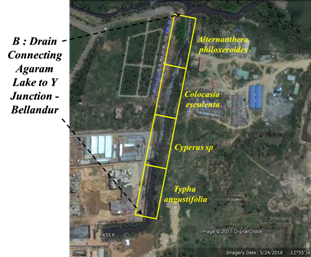
Figure 3.5: Treatment model along channel connecting Agaram Bellandur Lakes (B)
About 102 MLD of untreated sewage water comes into the Bellandur lake from ST lake bed side catchment. The area of the wetland is nearly 105 acres in the Bellandur lake upstream, and the depth varies between 0.5 m to about 1.5 m with an approximate average depth of 0.8 m. with the existing area and depth, volume of water that can be stored in the wet land is nearly 340 Million Liters. With respect to the discharge of Sewage at 102 MLD, residence time of 3.3days is available at the wetland portion of the lake. The existing macrophytes pockets in the wetlands is as depicted in Figure 3.6a (white coloured polygons). These macrophyte clusters needs to be retained in the system in order to treat the incoming sewage. The flow of sewage can be regulated (Figure 3.6a – yellow arrows) through planned channels without disturbing the existing clusters of macrophyte cover, and providing more residence time, and contact with the macrophytes. A broad crested weir at the outlet of the planned wetland would also help in increasing the residence time and improving aeration at the fall. Figure 3.6b provides the suggested wetland (with meandering drains – allowing the gravity flow) with tree (native species) barricades.
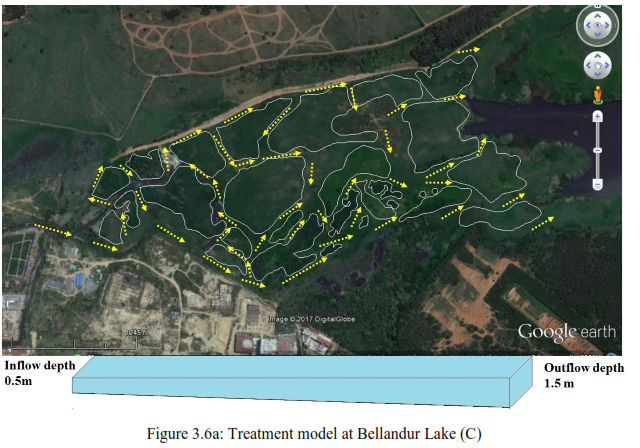

|
Dr. T.V. Ramachandra
Centre for Sustainable Technologies, Centre for infrastructure, Sustainable Transportation and Urban Planning (CiSTUP), Energy & Wetlands Research Group, Centre for Ecological Sciences, Indian Institute of Science, Bangalore – 560 012, INDIA.
E-mail : tvr@iisc.ac.in
Tel: 91-080-22933099/23600985,
Fax: 91-080-23601428/23600085
Web: http://ces.iisc.ac.in/energy
Vinay SEnergy & Wetlands Research Group, Centre for Ecological Sciences, Indian Institute of Science, Bangalore – 560 012, INDIA.
E-mail: svinay@iisc.ac.in
Sudarshan BhatEnergy & Wetlands Research Group, Centre for Ecological Sciences, Indian Institute of Science, Bangalore – 560 012, INDIA.
E-mail: sudarshanb@iisc.ac.in
Bharath SetturEnergy & Wetlands Research Group, Centre for Ecological Sciences, Indian Institute of Science, Bangalore – 560 012, INDIA.
E-mail: setturb@iisc.ac.in
Bharath H. AithalEnergy & Wetlands Research Group, Centre for Ecological Sciences, Indian Institute of Science, Bangalore – 560 012, INDIA.
E-mail: bharathh@iisc.ac.in
Citation:Ramachandra T V, Vinay S, Sudarshan Bhat, Bharath Settur, Bharath H. Aithal, 2017. Unabated Violations in Agara Bellandur Wetland, ENVIS Technical Report 134, Environmental Information System, CES, Indian Institute of Science, Bangalore 560012
| Contact Address : |
| |
Dr. T.V. Ramachandra
Energy & Wetlands Research Group,
Centre for Ecological Sciences, TE 15, New Biology Building, Third Floor, E Wing, [Near D Gate], Indian Institute of Science, Bangalore – 560 012, INDIA.
Tel : 91-80-22933099 / 22933503-extn 107
Fax : 91-80-23601428 / 23600085 / 23600683 [CES-TVR]
E-mail : tvr@iisc.ac.in, energy@ces.iisc.ac.in,
Web : http://wgbis.ces.iisc.ac.in/energy |
|